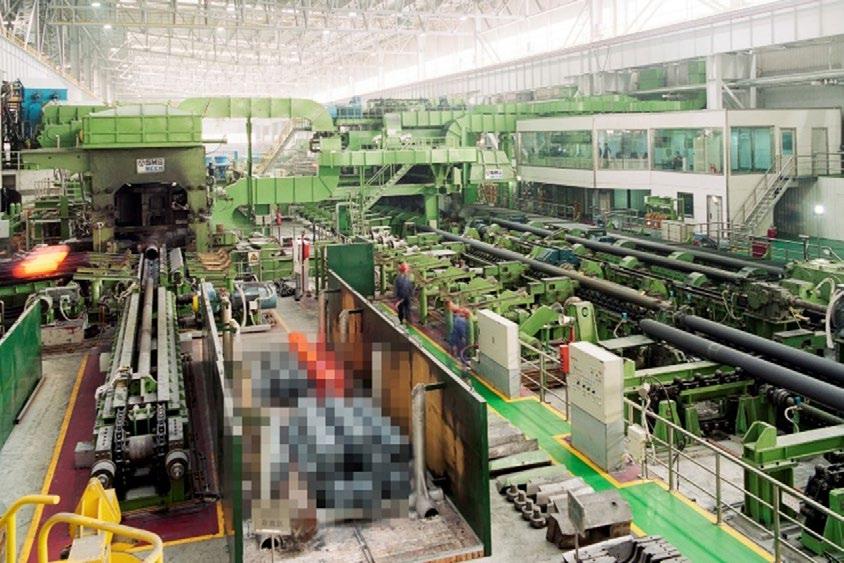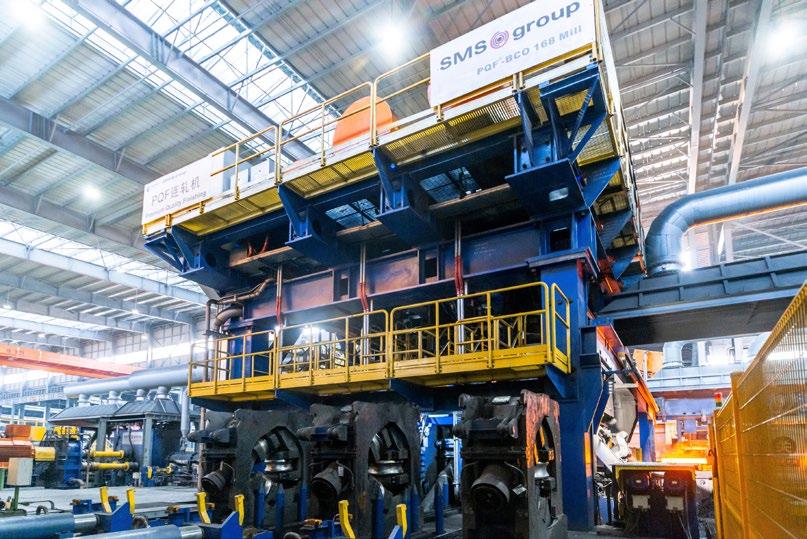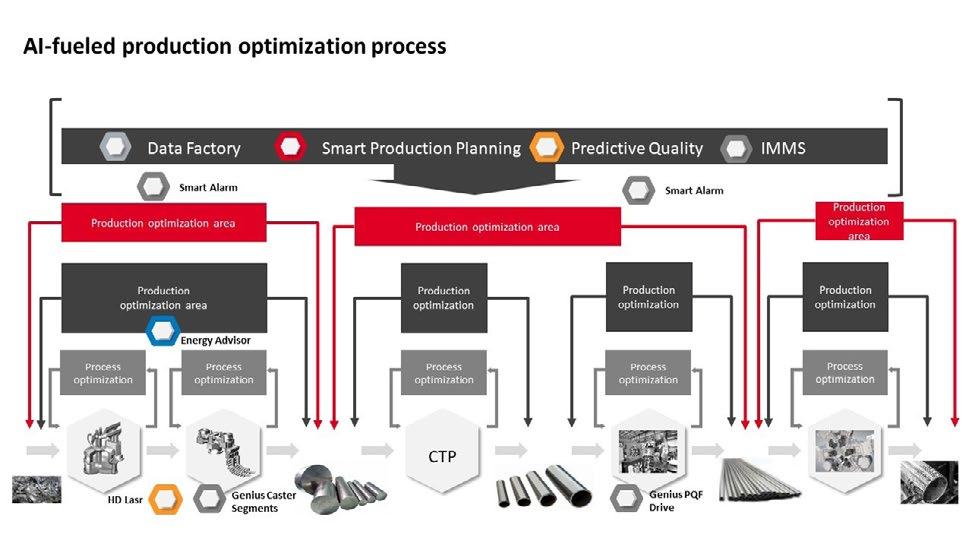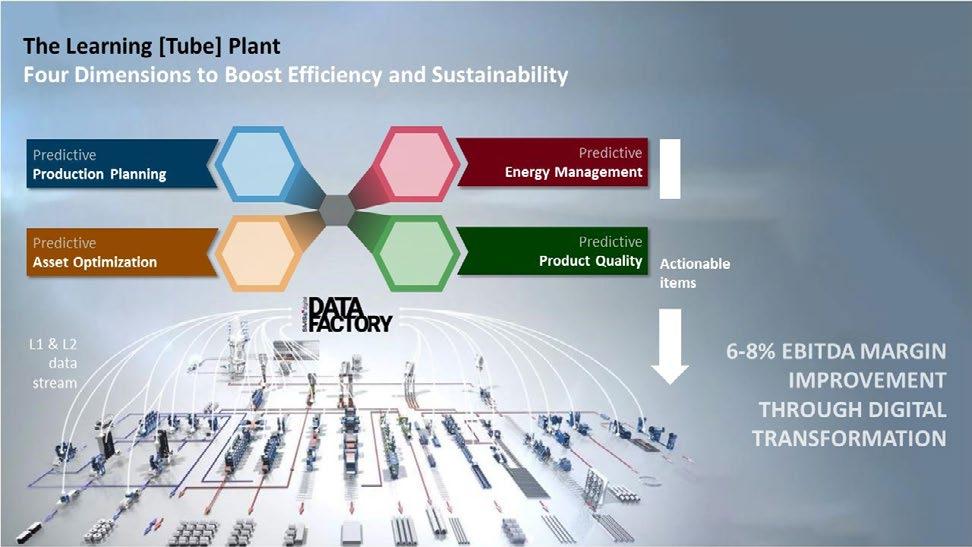
5 minute read
4th PQF® generation – New horizons in seamless tube production
edited by: M. Leferink
Over the last two decades, SMS has commissioned 21 PQF® plants featuring three-roll retained mandrel mill technology for all leading companies in the seamless tube industry. These producers have recognized that this technology is opening up new possibilities for rolling tubes and pipes with better, tighter tolerances as well as steel grades with higher alloy content and material yields, and offers operating personnel far greater flexibility.
In this paper, SMS describes the fourth and latest generation of PQF® plants. This patent-pending solution will be yet another milestone in the PQF® success story and represents a quantum leap in productivity in seamless tube production. SMS experts have improved the original solution by aiming to increase output by up to 30% with this fourth generation of PQF® plant. This gain is not only possible with new plants; existing PQF® plants can also fully benefit from this with a low-investment upgrade.
INTRODUCTION: HISTORY OF PQF® DEVELOPMENT
SMS group is renowned worldwide for its future-oriented technologies and outstanding service for the metals industry. The company applies its 150 years of experience and its digital know-how to provide the industry continuously with innovative products and processes –even beyond its core business – and generates worldwide sales of around 2.6 billion euros. As a global player with German roots, SMS takes responsibility for its 14,500 employees. SMS is the right partner for challenging projects and supports its customers throughout the lifecycle of their plants, enabling profitable and resourceefficient value creation chains. Paving the way to a carbonneutral and sustainable metals industry is the company’s stated goal.
In 2003, SMS opened a new chapter in seamless tube production with the first PQF® installation. Now, SMS has commissioned the 21st PQF® with the third generation of BCO design (Table 1).
In 2021, SMS developed the fourth and latest generation of PQF® (Premium Quality Finishing) plant. Looking ahead, this new, high-speed generation is on course to set benchmarks in terms of quality, energy efficiency, and above all productivity and profitability.
Manfred Leferink SMS group GmbH, Germany
Tab.1 - Evolution of PQF® design development.
Evolution of PQF® design development
Type of PQF® design Year of introduction Generation No. of references
ACO – Axial Change Over 2003 1st 8
LCO – Lateral Change Over 2005 2nd 11
BCO – Bilateral Change Over 2015 3rd 3
BCO – High speed 2021 4th -
7-inch BCO-type PQF® at Jiangsu Changbao Precision Steel Tube Co, Ltd.
In spite of the difficult circumstances during the pandemic in China and around the world, Jiangsu Changbao and SMS successfully commissioned the latest 7-inch BCO-type
PQF® mill (see Fig. 1) on time as per the original project schedule. With six rolling stand positions in the PQF®, it meets the growing demand for precise, high-strength seamless tubes.
Fig.1 - Advanced third PQF® generation with six rolling stands.
Fourth generation of PQF® tube mill
Back in the early eighties, SMS commissioned a 7-inch freefloating mandrel mill at Baowu, Baoshan works, which is still the world’s most productive tube mill, manufacturing more than 800,000 tons of quality tubes in rolling cycles of 13.3 seconds and up to 270 pieces per hour. Now, SMS has combined the high-capacity version of earlier free-floating and semi-floating mandrel mills with the high-quality PQF® BCO-type mill and developed a new process for the fast inlet side of the mandrel mill.

To achieve higher piece rates of up to 200 pieces per hours and corresponding cycle times of only 18 seconds, the conventional process on the inlet side of the PQF® had to be modified, as shown in Figure 2.
Fig.2 - Necessary modification of PQF® inlet side for rapid mandrel handling.
A second, rack-type pre-inserter was introduced, which inserts the mandrel bar into the hollow bloom in front of the PQF® at a much higher speed compared to the retainers available on the market today. This reduces the operating time dramatically. Due to the offside arrangement of the new retainer design, you also have the option of transferring the mandrel bar earlier out of the rolling line. This also reduces the operating time of one rolling cycle.

All in all, the new design solutions reduce the cycle time by approx. six seconds compared to the three-roll retained mandrel mills currently in operation worldwide.

Fig.3 - Plant view with cone-type piercing mill, PQF®, and fast inlet side for rapid mandrel handling.
The functionality and process of the fast inlet side of the PQF® can be briefly described as follows: The hollow bloom coming from the piercing mill is picked up by a manipulator from the deoxidation position and lowered directly onto the rolling line in front of the PQF®. The pre-inserter inserts the mandrel bar, which is already prepositioned, at high speed.
The head of the off-site retainer accelerates and, at a welldefined point, the so-called “hand-over” from the preinserter to the retainer is executed. As soon as rolling is completed, the mandrel bar is transferred to the cooling line. The high-speed inlet side is combined here with a modern PQF® mill in the size range up to 7 inches.
This patent-pending solution will be yet another milestone in the PQF® success story and represents a quantum leap in productivity in seamless tube production.
SMS experts have improved the original solution by aiming to increase output by up to 30% with this fourth generation of PQF® plants.
Fig.4 - PQF® rolling process with fast inlet side for rapid mandrel handling.
This gain is not only possible with new plants; existing PQF® plants or two-roll mandrel mills can also fully benefit from this with a low-investment upgrade.
Digitalization and “The Learning Tube Plant”
There are different digital solutions on the market, but the SMS approach of “The Learning Tube Plant” goes beyond individual solutions. Four pillars (see Figure 5) have been identified for boosting the efficiency and sustainability of a seamless tube plant:
1. Predictive Production Planning to achieve the shortest lead times and minimal downtimes

2. Predictive Product Quality for “first class” tubes on the cooling bed and in the dispatch area
3. Predictive Energy Management

4. Predictive Asset Optimization.
Fig.5 - The Learning (Tube) Plant – four pillars for boosting efficiency and sustainability.
AI-fueled production optimization process
Artificial intelligence is consistently applied throughout the whole seamless tube production process, improving both the process and production.
The four pillars, combined with the digital AI concept of a DATA FACTORY, provide the foundation for the holistic approach to optimizing product quality and equipment conditions along the entire process route. Starting with the EAF (electric arc furnace) and continuous casting machine, the main rolling units of the hot mill area include the cone-type piercing mill, PQF® mill, sizing/stretchreducing mill, and of course the adjacent finishing lines and dispatch area.
Fig.6 - Artificial intelligence applied in seamless tube manufacturing.
Conclusion
PQF® – The standard of the future
Around 40 million tons of seamless tubes are produced worldwide every year, around half of these in highgrade PQF® quality. The main customer is the oil and gas industry, which uses OCTG tubes that are preferably made using the PQF® process. The reason is this: As the conditions for extracting fossil energy deposits become more and more extreme, the tubes must meet correspondingly high quality and load requirements. Existing obsolete equipment for seamless tubes can also be replaced by state-of-the-art, digitalized PQF® plants of the fourth generation, as shown in Figure 7.
Fig.7 - Side view with PQF® rolling stands for change-over operation.
Conventional seamless tube lines cannot viably compete either with the quality or enhanced future productivity of highprecision PQF® plants.

References
[1] Wilms M. Steel+Technology. 3(2021), 46-48 p.
[2] Leferink M. RusNITI Conference 2021, Chelyabinsk, Russia
[3] Kirchner W, Marin P, Rinaldi P. Device and method for handling mandrel rods in a tube rolling mill - Patent pending






